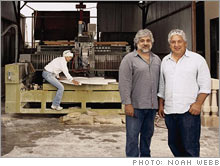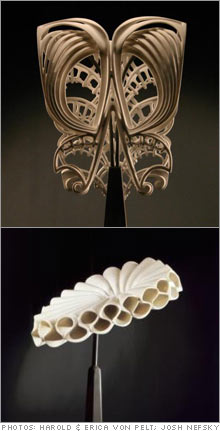|
Sculptor Support A marble yard hosts artists.
(FSB Magazine) -- On an overcast day in June, employees at Chiarini Marble & Stone are working on a limestone staircase, which they will hand-carve and fit to connect the three levels of a large San Diego home. The company, based in Santa Ana, Calif., creates architectural carvings for homes and businesses, and today's activity and noise are typical for an industrial compound: Forklifts transport 1,000-pound slabs of Italian marble, and 12-foot-long table saws roar inside open garages. The only detail that seems out of place is the slender 5-foot-7 woman working under a tent off to one side. As the dust from the men swirls around her, she quietly chisels away at her own marble block, wielding what looks like a set of dental tools fitted with tiny diamond blades.
The woman, Elizabeth Turk, 44, is a sculptor, one of dozens of fine artists that the 24-employee company unofficially sponsors. She is working on a series of carvings she hopes to showcase in art galleries around the country, the second body of work she has created on Chiarini property. For two decades brothers George and Richard Chiarini have provided free workspace, cutting and moving services and tools to struggling artists who work in marble or granite. The brothers also hire the artists for small jobs such as carving garlands into a stone fireplace. "There are very few places where you find someone working in stone, because of the dust, the weight," says George Chiarini, 53. "We're willing to help these artists accomplish whatever they're doing as best we can." An early appreciation for the arts Art appreciation was instilled in the Chiarini brothers in childhood, when they started hanging around their father's ceramic tile and stone company in Brooklyn. "As we started to do the smaller cutting and carving, he would insist that we investigate his greatest heroes - the artists of the Renaissance," says George, who travels to Europe about three times a year, seeking ideas for his clients. In 1978 the family moved to Southern California and found a niche installing granite and marble fixtures. The jobs soon grew bigger - from $4,000 countertops to multimillion-dollar contracts (they recently did work for Quincy Jones) - and today the company takes in revenues of nearly $50 million. Reaching out to artists In 1990 a photographer documenting the company's work introduced the Chiarinis to Francisco Rojas, a Colombian stone carver who was newly arrived in the U.S. and needed work. For the next two years the company paid Rojas to carve and polish stone for its customers and also provided him with space and tools to work on his art - mostly carved portraits, which he later displayed in U.S. galleries. He became the first of six Chiarini-sponsored sculptors to land gallery shows for work produced on the company's property. (Today Rojas does restoration work for the Louvre.) Over the years the family has also helped more than 100 art students and first-time carvers, donating low-end marble and rent-free studio space. They have no formal screening process - all artists are introduced via word of mouth - and take no tax deduction for their donated space and material (though Rojas thanked them with a sculpture of their family). "Artists have this sense of 'No matter what, I have to do this,' " says George. "That's fascinating to me, and it gives me the encouragement to not give up on my own ideas." In 2001, Richard Chiarini met Turk, who had just fled her cramped, eighth-floor studio in New York City to become artist-in-residence at California State University at Fullerton. She was working on "The Collars," a 20-piece body of work that included delicate bone- and lace-like sculptures carved from 400-pound blocks of marble. (Some of the pieces are shaved so thin that light shows through.) The Chiarinis offered Turk space at their company, and for the next three years she worked alongside them, saving about $54,000 on rent, materials such as marble and resin, and shipping costs for her work. When she finally finished "The Collars," it was displayed at the Mint Museum of Art in Charlotte for three months and, earlier this year, at the Hirschl & Adler Modern gallery in New York City. "Turk's sculptures skew the historical definition of women's work - they're a nod to the centuries-old tradition of making handmade lace," said a review in Women's Wear Daily. Turk sold several pieces, at $5,000 to $150,000 each. In June she returned to the Chiarini compound to start a new series inspired by water, which she plans to finish late next year. She calls the Chiarinis' help "invaluable" to her work. "It's so much easier to work outside year-round," she says. "I never want to leave." Do you believe in businesses supporting the arts? In what way does your business promote fine art? Let us know. ___________________________________ Turning bicycles into lounge chairs To write a note to the editor about this article, click here. |
|


